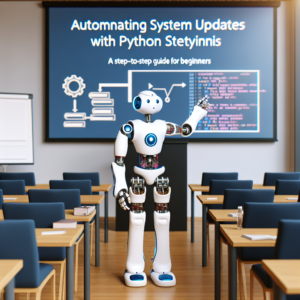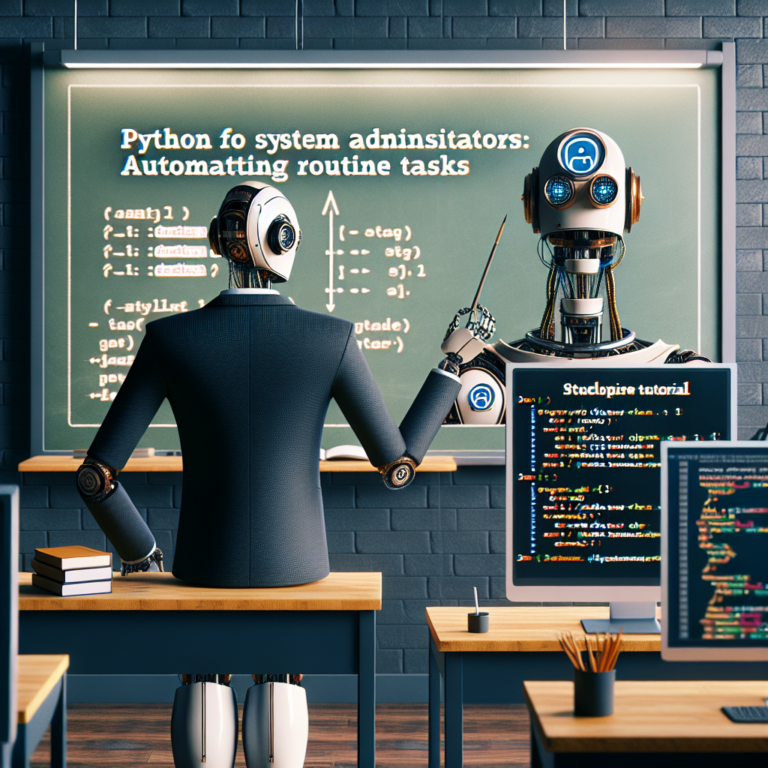1. Understanding Python Automation for System Updates
Automating system updates using Python can significantly streamline the maintenance of your computer systems, ensuring they remain up-to-date with the latest security patches and features. This section will guide you through the basics of Python automation, focusing on its application in managing system updates.
Python automation involves writing scripts that automatically execute tasks which would otherwise be done manually. In the context of system updates, these scripts can schedule and apply updates without user intervention, making the process both efficient and error-free.
To begin with, Python offers several libraries such as subprocess and os that are essential for creating automation scripts. These libraries allow your scripts to interact with the operating system, executing necessary commands to check for, download, and install updates. Here’s a simple example of a Python script that checks for system updates:
import subprocess
def check_for_updates():
try:
# Command to check for updates, specific to the OS
subprocess.run(['sudo', 'apt-get', 'update'], check=True)
print("Update check completed successfully.")
except subprocess.CalledProcessError:
print("Failed to check for updates.")
check_for_updates()
This script uses the subprocess module to run system commands that check for updates. It’s tailored for Debian-based Linux systems, utilizing apt-get update to refresh package indexes. For other operating systems, the command inside subprocess.run() would need to be adjusted accordingly.
Understanding the basics of Python scripting and the modules available for interacting with the system is the first step towards automating your system updates. As you become more familiar with Python’s capabilities, you can extend your scripts to handle more complex tasks, such as automatically installing updates or even handling system reboots when necessary.
By automating these processes, you not only save time but also reduce the risk of human error, ensuring that your systems are always running the latest software versions without requiring constant manual oversight.
2. Setting Up Your Environment for Python Scripts
Before you can start automating system updates with Python, you need to set up a proper development environment. This setup is crucial for ensuring that your scripts run smoothly and interact effectively with your operating system.
Step 1: Install Python
First, ensure that Python is installed on your system. You can download it from the official Python website. Make sure to add Python to your system’s PATH to run Python commands from the command line.
Step 2: Install Necessary Libraries
Python’s strength in automation comes from its rich ecosystem of libraries. For system updates, libraries like os and subprocess are essential. Install them using pip:
pip install os-sys pip install subprocess.run
Step 3: Set Up a Virtual Environment
It’s a good practice to use a virtual environment for your Python projects. This isolates your project’s libraries from the global Python environment. You can create one using:
python -m venv myenv source myenv/bin/activate # On Windows use `myenv\Scripts\activate`
Step 4: Verify the Setup
After setting up, verify that everything works correctly by running a simple Python script that prints your system information. This confirms that Python and the necessary libraries are functioning as expected.
import platform print(platform.system(), platform.release())
By following these steps, you prepare your system not just for basic Python scripting but also for more advanced tasks like automating system updates. This setup ensures that your scripts have the necessary permissions and environment to execute potentially system-altering operations safely.
With your environment ready, you can now proceed to write scripts that automate various system update tasks, enhancing the efficiency and reliability of your system maintenance procedures.
3. Writing Your First Python Script for System Updates
Now that your environment is set up, it’s time to dive into writing your first Python script for automating system updates. This script will be simple yet foundational, providing a base for more complex automation tasks.
Understanding the Script’s Purpose
The primary goal of this script is to automate the checking and installing of system updates. This is crucial for maintaining system security and functionality.
import os
import subprocess
def update_system():
print("Checking for updates...")
result = subprocess.run(['sudo', 'apt-get', 'update'], capture_output=True, text=True)
if 'packages can be upgraded' in result.stdout:
print("Updates available. Installing updates...")
subprocess.run(['sudo', 'apt-get', 'upgrade', '-y'])
print("Updates installed successfully.")
else:
print("Your system is up to date.")
update_system()
This script uses the subprocess module to interact with the system’s package manager, checking for and installing updates. It’s designed for Debian-based systems, using apt-get commands.
Key Points to Note:
– The script checks for updates and automatically installs them if available.
– It provides clear output messages to inform you of the process status.
– Ensure you have the necessary administrative permissions to run update commands.
By automating this process, you reduce the risk of human error and ensure your system is always protected with the latest security patches. This script serves as a stepping stone to more advanced Python automation tasks, such as scheduling these updates or integrating error handling and logging.
With this script, you’ve taken a significant step towards automating your system maintenance tasks using Python, making your updates more efficient and reliable.
4. Testing and Debugging Python Scripts
After writing your Python script for system updates, the next crucial step is testing and debugging to ensure it functions as expected. This phase helps identify and resolve any issues before the script is deployed for regular use.
Testing Your Script
Begin by running your script in a controlled environment. Monitor its execution to verify that it checks for updates, installs them if available, and handles errors without crashing. Use test cases that simulate both typical and atypical scenarios.
# Example of a test case for update availability
def test_update_available():
output = subprocess.run(['sudo', 'apt-get', 'update'], capture_output=True, text=True)
assert 'packages can be upgraded' in output.stdout
# Example of a test case for no updates available
def test_no_update_available():
output = subprocess.run(['sudo', 'apt-get', 'update'], capture_output=True, text=True)
assert 'All packages are up to date' in output.stdout
Debugging Tips
If your script fails any tests, use Python’s debugging tools like logging and breakpoints to find the root cause. Insert logging statements to track the script’s flow and output at critical points:
import logging
logging.basicConfig(level=logging.DEBUG)
logger = logging.getLogger()
def update_system():
logger.debug("Starting update check...")
result = subprocess.run(['sudo', 'apt-get', 'update'], capture_output=True, text=True)
logger.debug(f"Update check output: {result.stdout}")
if 'packages can be upgraded' in result.stdout:
logger.debug("Updates available. Installing updates...")
subprocess.run(['sudo', 'apt-get', 'upgrade', '-y'])
logger.debug("Updates installed successfully.")
else:
logger.debug("No updates available.")
By incorporating these testing and debugging practices, you ensure that your Python script for system updates is robust and reliable. This not only enhances the script’s effectiveness but also minimizes potential disruptions during its practical deployment.
Remember, the goal is to automate system updates efficiently and safely, reducing the need for manual intervention and the risk of human error.
5. Scheduling Python Scripts for Regular System Updates
Once you have your Python script ready for system updates, the next step is to automate its execution. Scheduling your scripts to run at regular intervals ensures your system remains updated without manual intervention.
Using cron on Linux
For Linux users, `cron` is a powerful tool used to schedule scripts. Here’s how to set up a cron job for your Python script:
# Open your crontab file crontab -e # Add a new cron job 0 3 * * * /usr/bin/python3 /path/to/your/script.py
This cron job is set to run the script daily at 3 AM. Adjust the time and path according to your needs.
Using Task Scheduler on Windows
Windows users can utilize the Task Scheduler to run Python scripts:
# Open Task Scheduler and create a new task # Set the trigger to the desired time and frequency # Action to start a program: python.exe # Add arguments: path\to\your\script.py
Ensure the paths to `python.exe` and your script are correct.
Key Considerations
When scheduling scripts, consider the following to ensure smooth operation:
- Check script permissions and run levels.
- Log outputs to a file for error tracking.
- Ensure your computer is on at the scheduled time.
By automating the execution of your Python script, you can maintain system security and performance with minimal effort. This setup not only saves time but also enhances the reliability of your system updates.
6. Best Practices for Python Automation Security
When automating system updates with Python, it’s crucial to prioritize security to protect your systems from potential threats. This section outlines key practices to enhance the security of your Python automation scripts.
Use Secure Coding Practices
Always validate and sanitize inputs to your scripts to prevent injection attacks. Avoid running your scripts with administrative privileges unless absolutely necessary.
Manage Secrets Safely
Never hard-code sensitive information like passwords or API keys directly in your scripts. Use environment variables or secure vaults like HashiCorp Vault to manage secrets securely.
import os
# Example of using an environment variable for a sensitive command
password = os.environ.get('MY_SECRET_PASSWORD')
subprocess.run(['sudo', '-S', 'apt-get', 'update'], input=password, text=True)
Regularly Update and Patch
Keep your Python environment and any dependencies up-to-date. Regular updates reduce the risk of vulnerabilities that could be exploited by attackers.
Implement Logging and Monitoring
Set up logging to record script activities, especially errors and unusual behaviors. Monitoring these logs can help you detect and respond to security incidents promptly.
import logging
logging.basicConfig(filename='update_log.log', level=logging.INFO)
logger = logging.getLogger()
def perform_update():
logger.info("Update started")
try:
subprocess.run(['sudo', 'apt-get', 'upgrade', '-y'])
logger.info("Update completed successfully")
except Exception as e:
logger.error(f"Update failed: {e}")
By adhering to these best practices, you ensure that your Python scripts for automating system updates are not only effective but also secure. This minimizes risks and protects your systems from potential security breaches.



